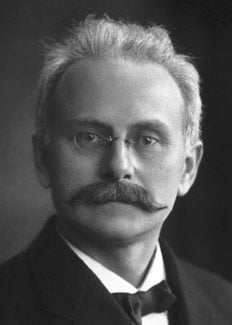Johannes Stark
Biographical
 Johannes Stark was born on April 15, 1874 in Schickenhof, Bavaria; his father was a landed proprietor. He was educated at the Gymnasium (grammar school) in Bayreuth and later in Regensburg and proceeded to Munich University in 1894 to read physics, mathematics, chemistry and crystallography. Stark graduated in 1897 on the basis of his doctoral dissertation on Newton’s electrochronic rings in a certain type of dim media. He worked as assistant to von Lommel at the Physics Institute at Munich University from 1897 until 1900 and then became unsalaried university lecturer of physics at the University of Göttingen. In 1906 he was appointed extraordinary professor at the Technische Hochschule in Hannover and in 1909 he followed the invitation of the Technische Hochschule in Aachen to become Professor there. A similar appointment at the University of Greifswald followed in 1917. Three years later he moved to the Physics Institute of the University of Würzburg, where he stayed until 1922.
Johannes Stark was born on April 15, 1874 in Schickenhof, Bavaria; his father was a landed proprietor. He was educated at the Gymnasium (grammar school) in Bayreuth and later in Regensburg and proceeded to Munich University in 1894 to read physics, mathematics, chemistry and crystallography. Stark graduated in 1897 on the basis of his doctoral dissertation on Newton’s electrochronic rings in a certain type of dim media. He worked as assistant to von Lommel at the Physics Institute at Munich University from 1897 until 1900 and then became unsalaried university lecturer of physics at the University of Göttingen. In 1906 he was appointed extraordinary professor at the Technische Hochschule in Hannover and in 1909 he followed the invitation of the Technische Hochschule in Aachen to become Professor there. A similar appointment at the University of Greifswald followed in 1917. Three years later he moved to the Physics Institute of the University of Würzburg, where he stayed until 1922.
Stark’s scientific works cover three large fields: the electric currents in gases, spectroscopic analysis, and chemical valency. His spectroscopic work deals with the connection between the alteration in the structure and in the spectrum of chemical atoms. In 1919 Stark was awarded the Nobel Prize for Physics for his “discovery of the Doppler effect in canal rays and the splitting of spectral lines in electric fields”. The prize enabled him to set up his own private laboratory.
In 1933 Stark was elected President of the Physikalisch-Technische Reichsanstalt (Physico-Technical Institute) as successor to von Paschen, where he remained until his retirement in 1939. At the same time he held the post of President of the Deutsche Forschungsgemeinschaft (German Research Association).
Stark was a prolific writer and published more than 300 scientific papers. His book Die Elektrizität in Gasen (Electricity in gases) was published in 1902. This was followed by works on elementary radiation and electrical spectroscopic analysis of chemical atoms. In connection with his work on chemical valency he wrote a book Die Elektrizität im chemischen Atom (Electricity in the chemical atom). Stark founded the Jahrbuch der Radioaktivität und Elektronik (The Year Book of Radioactivity and Electronics) and edited this publication from 1904 until 1913.
Johannes Stark was a corresponding member of the Academies in Göttingen, Rome, Leyden, Vienna and Calcutta, and was awarded the Baumgartner Prize of the Vienna Academy of Sciences in 1910 and the Vahlbruch Prize of the Göttingen Academy of Sciences in 1914, and also the Matteucci Medal of the Rome Academy.
During the last years of his life Stark, in his private laboratory on his country estate Eppenstatt near Traunstein in Upper Bavaria, investigated the effect of light deflection in an unhomogeneous electric field.
He was married to Luise Uepler. They had five children. His recreations were forestry and cultivation of fruit trees.
Stark died on June 21, 1957.
This autobiography/biography was written at the time of the award and first published in the book series Les Prix Nobel. It was later edited and republished in Nobel Lectures. To cite this document, always state the source as shown above.
Nobel Prizes and laureates
Six prizes were awarded for achievements that have conferred the greatest benefit to humankind. The 14 laureates' work and discoveries range from quantum tunnelling to promoting democratic rights.
See them all presented here.
